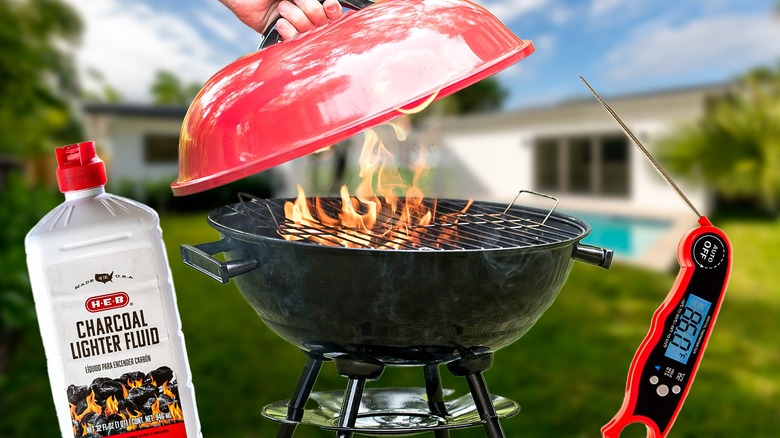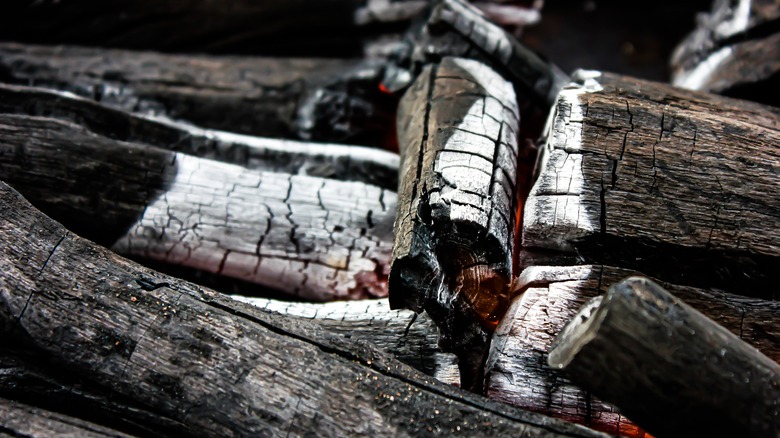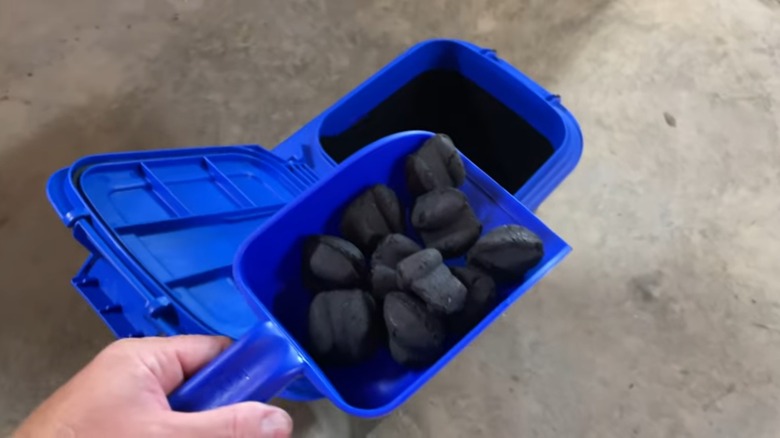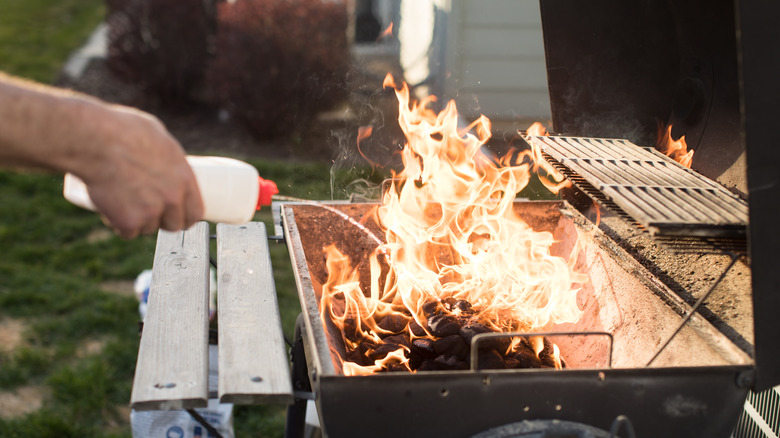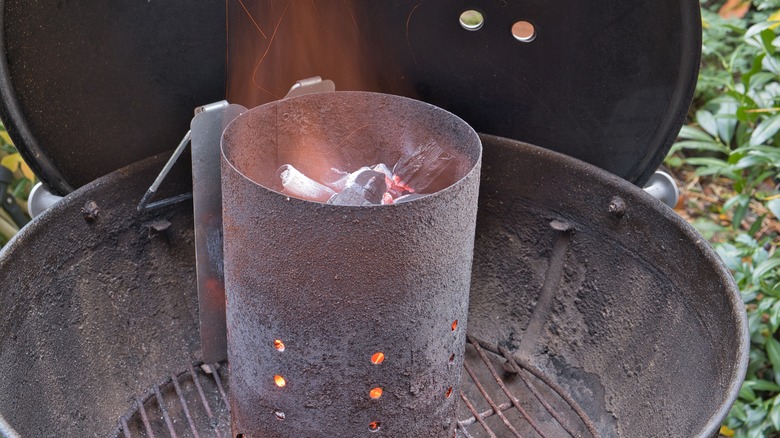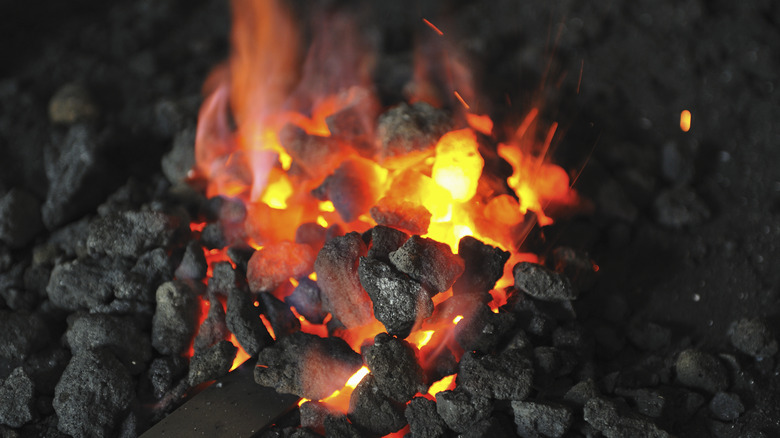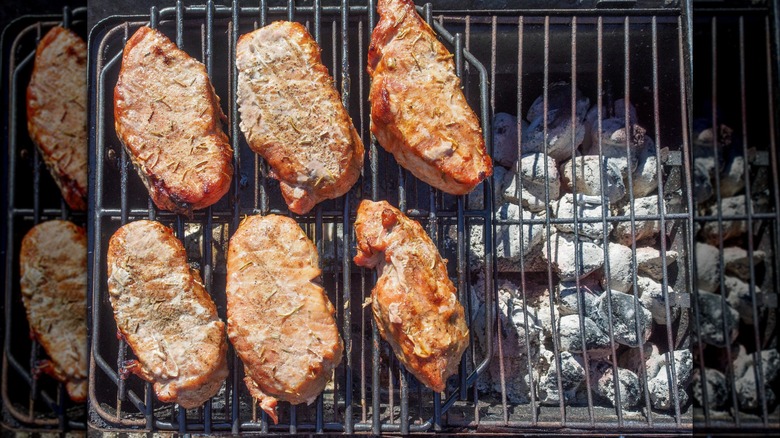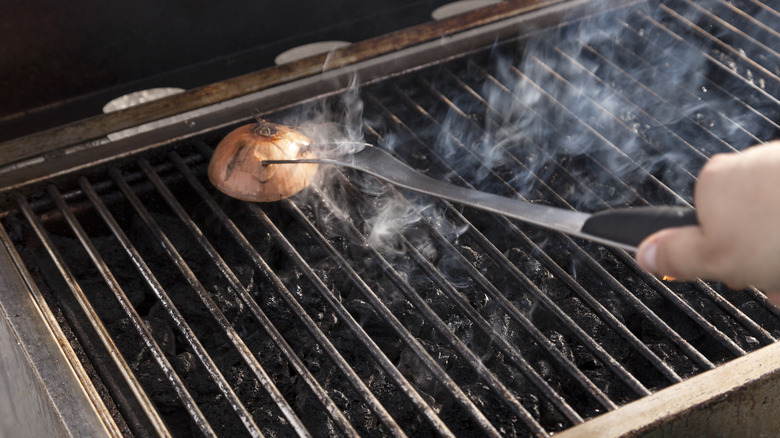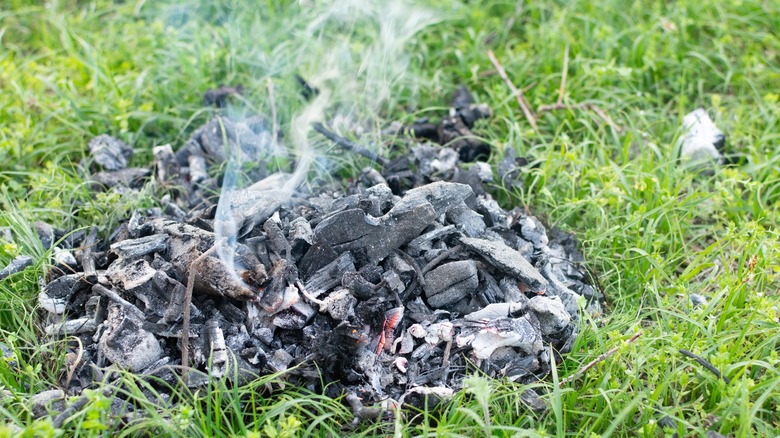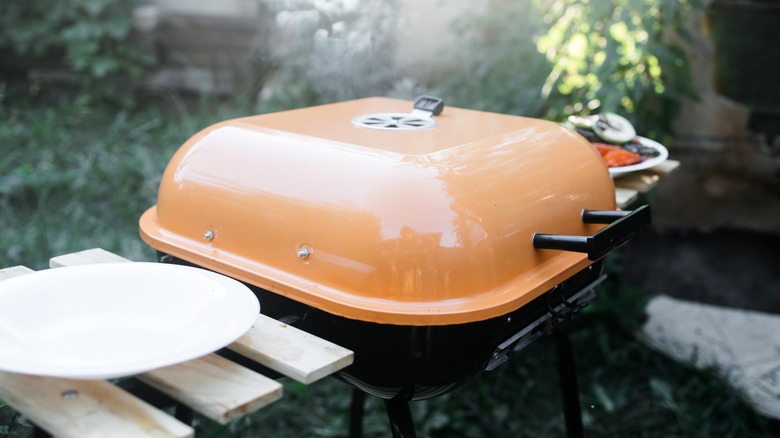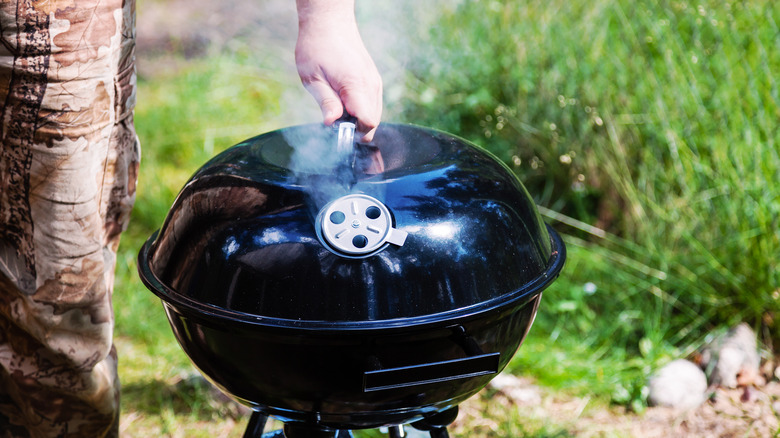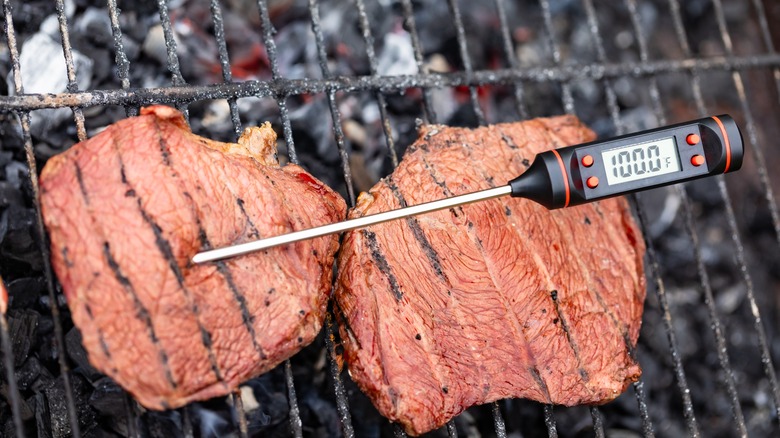11 Common Mistakes People Make With Charcoal BBQ
There's never a bad time of year to grill. But it's especially popular when the weather turns nice, the game is on, or you have a few people over. These are the times when you want to move the party outside and enjoy an iced cold beer and a delicious plate of barbecue. But before you cook the perfect hamburger or tri-tip, you need to make sure your grill is set up the correct way and that you have everything you need. Are you using charcoal briquettes or wood? Do you have the right tools? Is your protein seasoned exactly the way you want it?
While grilling has been around for decades, so have the mistakes that often go with it. How many times have you had the grease from that burger set the fire ablaze and ended up with a well-done patty instead of that nice medium-rare you wanted? Or maybe you accidentally threw your smoldering coals out before they were just ash and watched as your trash bin went up in flames. Don't worry; we've all made these and several other mistakes. But since we really want to try and eliminate any future grilling issues, we sat down with barbecue and smoking maven Steven Raichlen during his annual Barbecue University to find out what some of the most common mistakes are and how to avoid them the next time we want to grill.
Not understanding the different types of charcoal
You've decided to forgo the gas and go with the more classic charcoal grill. There's just one problem: With so many different types of charcoal, which one will give you the best results? Briquettes are the easiest to find and usually produce a consistent burn. But they also come with additives that, while making them easier to light, could also affect the flavor of your food. Steven Raichlen isn't a fan but understands they have a time and place. "I personally prefer natural lump charcoal rather than briquettes because briquettes contain borax, petroleum binders," he explains. "But briquettes have a place, and if you call the big barbecue festivals — Kansas City, Royal Memphis, and Maine — the teams all use briquettes."
Then there's Raichlen's preference: natural lump charcoal. The benefit of lump charcoal is right in its name. It's all-natural, which means no chemicals. The end result is a cleaner burn that's easier to control and will result in a more even and better-tasting cook. The disadvantage, though, is that it can burn quicker and tends to be more expensive since you probably won't find it at your local grocery store.
Finally, there's hardwood. This is as natural as you can get, but that also means it's the most erratic. Sure, it'll light quickly, but it also burns quickly. The reason people like to use hardwood is the flavor. The smoke from the wood seeps into the fibers of the meat and gives it those wonderful cherry, apple, or hickory flavors.
Damp charcoal could lead to mold
No matter what type of charcoal you choose, how you store it is just as important as how you cook with it. While most people will grab a bag and simply drop it right next to their grill, that can create a whole separate string of problems. If the bag is just sitting out in the open, the elements will eventually affect the charcoal. It won't matter during the summer, but once the weather turns and you start having heavy mists or rain, most likely, that bag is going to get wet. A wet bag means wet charcoal and wet charcoal is "hard to ignite," warns Steven Raichlen. "It gets crumbly. It'll eventually get moldy," he continues.
That moldy charcoal leads to a moldy flavor that Raichlen says, no matter how hot the fire is, won't burn off. But the barbecue master says this is one problem that's easily avoidable. All you need to do is store the charcoal properly. While he uses a metal trash can, there are other alternatives available like plastic bins or even plastic trash bags. As long as you keep water away from your charcoal, you'll be set.
Lighter fluid is always a bad idea
For a lot of us, a grilled meal meant watching Dad pour a bag of charcoal briquettes into his Weber grill, dousing it with lighter fluid, throwing a lit match on top, and watching a ball of flame explode. Steven Raichlen was no different. In fact, he says that his mother sometimes even used gasoline to get those coals going.
Yes, believe it or not, Raichlen wasn't always the barbecue expert he is now. He didn't grow up in a grilling family but says that his grandfather would light up the grill once a month during the summer, and his fire starter of choice was always lighter fluid. There was just one problem: There was always an unpleasant flavor in his food. Since that's all he knew about grilling, the chef just figured that's the way food was supposed to taste.
But after years of traveling the world and learning the art of barbecue, Raichlen discovered that chemical aftertaste wasn't normal. It simply meant that his family hadn't waited long enough to start cooking. Raichlen says that typically, the people who use lighter fluid tend to use briquettes rather than natural, lump charcoal, so they "don't let the coals get lit completely, and then you get a slight petroleum aftertaste," he continues. But if you wait for the briquettes to turn completely white with ash before placing your food on the grates, Raichlen says that "virtually all of the petroleum flavor burns off."
Don't forget the chimney starter
Even without lighter fluid, there's an easy way to get your coals going: a chimney starter. If you're unfamiliar with a charcoal chimney, it's a metal cylinder that's separated into two sections. The bottom is for newspaper or food-safe fire starters, and the top is for charcoal. Once it's ready, the chimney is placed on the grill, and the paper is lit.
As the paper or fire starters burn, they ignite the charcoal. Because the charcoal is piled together in a small, vertical space, the coals will light more quickly. In fact, Steven Raichlen says it only takes about 15-20 minutes for your coals to be ready when you use a chimney, and it's pretty easy to tell if they're good to go or not. "If you're using briquettes, what you look for is the briquettes will glow orange and just start to be covered with gray ash. If you're using natural lump charcoal, it'll glow orange."
The chimney is a much more efficient way to get your coals going, and since heat rises, it will only take a few minutes for the coals to light naturally and be the perfect heat source to grill your favorite protein. But the best thing about using a chimney starter is that you can toss that nasty jug of lighter fluid in the trash.
Using too much charcoal
While the chimney starter is a great tool to get your coals going, you have to be careful how much charcoal you place inside. You want to fill it to the top, but don't pack it. If you pack the chimney, there won't be enough oxygen, and the coals won't light evenly, especially those toward the top. If the coals aren't lit correctly, you'll end up having an uneven fire and a poor cooking option.
On the other hand, if you load up your chimney with a ton of charcoal, making sure there's enough air circulating to get the coals lit evenly, once you dump them into your grill, you could run the risk of creating a fire that's simply too hot. Sure, it'll heat your grill grates up quickly, but it could cook your proteins too quickly as well, leaving you with a meal that's well done on the outside and undercooked or even raw on the inside.
If, however you think you'll simply start off with less charcoal and add as you cook, that creates problems of its own. First, you'll have to move your proteins off the grill grates in order to remove them and add more charcoal. But worse than that, adding cold charcoal to your white-hot coals will cool the overall temperature of your grill. This will not only add to your cooking time; it could potentially create an uneven cook.
Grilling zones keep the fire from controlling you
Once your chimney is set and the coals are covered with a nice white ash, it's very easy to dump them out into one big pile and have a raging fire. There's just one problem with that plan: If you get in trouble and have a flare-up or discover that your protein is cooking too quickly, you have nowhere to move the meat so it doesn't burn. Or even worse, it gets charred on the outside but remains completely raw on the inside.
So, to combat this very common mistake, Steven Raichlen says one of the most important things to remember when grilling is that you control the fire rather than letting it control you. And the best way to do that is by "building a tiered fire." While there are plenty of barbecue masters that recommend having two different heat zones when grilling, Raichlen prefers having three: a high heat zone, a medium heat zone, and a safety zone. "One mistake is not leaving a safety zone," Raichlen explains. "Part of your grill [that's] coal-free. So, if the fire gets out of control, you get a flare-up, you have a place to move [your food]." That safety zone allows you to take a minute to let the heat die down while your food continues to cook without getting burned to a crisp.
Clean the grates before and after you grill
Starting with a clean grill is one of the most critical things we can do when grilling. It's also the easiest. But believe it or not, people often forgo this extra step because they want to eat their food as soon as it's ready. We totally understand the urge, but failing to complete this simple yet all-important step is a huge mistake. Not only will you be leaving little bits of food behind, Steven Raichlen tells us that you'll also be leaving unwanted residue on those metal grates and maybe even rust if you live near the beach. So, he recommends cleaning your grill before and after you cook because that's when the grates will be the easiest to clean. "It's very easy to clean a hot grate," he explains. "It's very hard to clean a cold grate."
So, before the food goes on the grill make sure those grates are hot, clean, and then "lubricate" them so the food doesn't stick. One way to do that is with an onion. That onion not only adds flavor, it also cleans the grates while making them slick with its juices. But if you don't want to use an onion, Raichlen says, "More and more people are cleaning grates ... with a wooden scraper rather than cleaning with a wired brush because of the rare but documented cases of the brush breaking up and leaving wires in the food."
Make sure your coals aren't still smoldering before tossing the ash
We mentioned how important a clean grill is, and believe it or not, that doesn't just apply to the grill grates. You also want to make sure to clean out most or all of the ash once you're done cooking. While it may seem easier to just leave it, this creates problems of its own. If you allow the ash to pile up over several cooks, that could impede the airflow needed to keep the fires burning. It could also cause the ash to get on your food, and we don't know anyone who likes the flavor of ash. So, the best plan is to get rid of it after every cook.
But be careful. You don't want to dump it too soon after the cook. While it may appear that the fire has been extinguished, it's possible there could still be a few smoldering embers hiding underneath. Steven Raichlen tells us that if you toss the ash immediately after you finish grilling, you could burn "through the bottom of the trash can," especially if it's plastic. He recommends waiting at least a day. "Feel it," he advises. "Stick your finger in it to make sure that it's really dead." Once you're sure the fire's out and the ash is cool, toss it in a metal trash can.
Keep the lid closed when cooking thicker proteins
We were sure that, just like an oven, you should keep your grill lid closed tight once your proteins go on until they're cooked and ready to serve, but Steven Raichlen gave us some interesting insight. "There's a big myth about that," the grill master explains, "that if you're cooking ribs and you open the lid, 'My God, it's going to add 20 minutes each time,'" he continues. "And if you think about the thermodynamics of a grill, that air reheats in a matter of minutes. So, that's not a big deal."
Wait, it's okay to crack the lid to sneak a peek at your proteins? Not exactly. Raichlen was nice enough to break it down even further, teaching us that you should always try and keep the lid closed when you're indirect grilling or grilling a thicker protein over direct heat, like a T-bone. But he added that you should keep the grill open if you're cooking "something really thin like a chicken paillard or shrimp." See, thinner proteins will cook much faster than those thicker ribeyes and porterhouses, and so run the risk of getting overcooked if the lid is closed. But if you keep it open, you can keep an eye on them and pull them off as soon as they're ready.
Those air vents aren't just for aesthetics
You may have noticed that your charcoal grill has at least one or two vents on the top of the lid and then another vent underneath. While they might look nice, it turns out they're very important when you grill. Unlike a gas grill, where you control the heat by the turn of a knob, the only way to control the live flame of a charcoal grill is with those vents and the air that flows directly through them. Something that Steven Raichlen confirms is "super important."
It's so important, in fact, the chef was nice enough to explain exactly when to open and close them. If you want a blazing fire, open the vents on the top and bottom all the way. That way, air flows in through the bottom and leaves out the top, giving the fire enough oxygen to get nice and hot. If, however, you want to temper your flames, Raichlen tells us that simply closing a vent or two "can really cool it down." But if you're not sure where to start, the grill master says, "It's easier to start with a cooler fire and heat it up than it is to start with a hotter fire and cool it down."
The okay test actually isn't okay if you want to be sure your protein is cooked correctly
It's finally time to eat. You've set up your grill with three different heat zones, cleaned your grates, cooked your proteins, and now it's time to pull off those beautiful steaks. But before you do, you want to be sure they're a perfect medium rare, or 130 to 145 degrees Fahrenheit. While you could use the popular "okay" test, Steven Raichlen doesn't recommend it.
One way to test your meat for doneness is to make the okay hand sign with each of your fingers, then feel the fleshy part of your palm at the base of your thumb. Depending on which finger you're making the sign with, the harder that part of your hand will get. A relaxed hand makes the base of your palm very soft and is what a raw piece of meat should feel like, whereas touching your pinky to your thumb leads to a harder palm, and so is probably what a well-done steak feels like. The only problem with that is that Raichlen says, "The physiology of everybody's hand is different." What could be medium on one person's hand could be well done on someone else's.
So, the only real way to know if your meat is done is to use a thermometer. A "meat thermometer is much more accurate," Raichlen explains. While he admits that he still occasionally uses the okay test, it's only when he's grilling a thin steak. Otherwise, "I definitely use a thermometer for chicken or a brisket."
